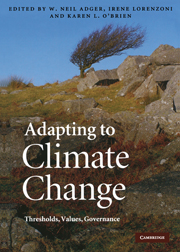Book contents
- Frontmatter
- Contents
- List of contributors
- Preface
- 1 Adaptation now
- Part I Adapting to thresholds in physical and ecological systems
- Part II The role of values and culture in adaptation
- 9 The past, the present and some possible futures of adaptation
- 10 Do values subjectively define the limits to climate change adaptation?
- 11 Conceptual and practical barriers to adaptation: vulnerability and responses to heat waves in the UK
- 12 Values and cost–benefit analysis: economic efficiency criteria in adaptation
- 13 Hidden costs and disparate uncertainties: trade-offs in approaches to climate policy
- 14 Community-based adaptation and culture in theory and practice
- 15 Exploring the invisibility of local knowledge in decision-making: the Boscastle Harbour flood disaster
- 16 Adaptation and conflict within fisheries: insights for living with climate change
- 17 Exploring cultural dimensions of adaptation to climate change
- 18 Adapting to an uncertain climate on the Great Plains: testing hypotheses on historical populations
- 19 Climate change and adaptive human migration: lessons from rural North America
- Part III Governance, knowledge and technologies for adaptation
- 31 Conclusions: Transforming the world
- Index
- References
11 - Conceptual and practical barriers to adaptation: vulnerability and responses to heat waves in the UK
Published online by Cambridge University Press: 31 August 2009
- Frontmatter
- Contents
- List of contributors
- Preface
- 1 Adaptation now
- Part I Adapting to thresholds in physical and ecological systems
- Part II The role of values and culture in adaptation
- 9 The past, the present and some possible futures of adaptation
- 10 Do values subjectively define the limits to climate change adaptation?
- 11 Conceptual and practical barriers to adaptation: vulnerability and responses to heat waves in the UK
- 12 Values and cost–benefit analysis: economic efficiency criteria in adaptation
- 13 Hidden costs and disparate uncertainties: trade-offs in approaches to climate policy
- 14 Community-based adaptation and culture in theory and practice
- 15 Exploring the invisibility of local knowledge in decision-making: the Boscastle Harbour flood disaster
- 16 Adaptation and conflict within fisheries: insights for living with climate change
- 17 Exploring cultural dimensions of adaptation to climate change
- 18 Adapting to an uncertain climate on the Great Plains: testing hypotheses on historical populations
- 19 Climate change and adaptive human migration: lessons from rural North America
- Part III Governance, knowledge and technologies for adaptation
- 31 Conclusions: Transforming the world
- Index
- References
Summary
Introduction
The health impacts of global climate change have long been a focus of discussion for researchers and policy-makers. In recent years the number of studies and reports on the theme has risen significantly, as reflected in the extended list of citations in the human health chapter of the latest Intergovernmental Panel on Climate Change (IPCC) assessment report (Confalonieri et al., 2007). Most of the analysis to date has concentrated on the epidemiological dimensions of disease and climate, investigating how climatic trends may alter the distribution, prevalence and health burden of diseases, and assessing how changes in extreme weather events and associated hazards may impact on health (for recent overviews see McMichael et al., 2003; Epstein and Mills, 2005; Watson et al., 2005). Increasingly, however, this work has begun to broaden and stimulate debate in the public health arena, with investigation extending to responses by individuals, communities and health system institutions. Within this mounting body of work, there has been an increasing movement towards a public health agenda for adaptation (for example Grambsch and Menne, 2003; Füssel and Klein, 2004; Ebi et al., 2005; Menne and Ebi, 2006). Yet, despite this progress, there remain surprisingly few empirical studies that concentrate on the intersection between climatic hazards, health, vulnerability and behaviour (Matthies et al., 2003; Few, 2007).
This chapter discusses a novel interdisciplinary approach to understanding the vulnerability of individuals to the effects of climate change and variability.
- Type
- Chapter
- Information
- Adapting to Climate ChangeThresholds, Values, Governance, pp. 181 - 196Publisher: Cambridge University PressPrint publication year: 2009
References
- 8
- Cited by



